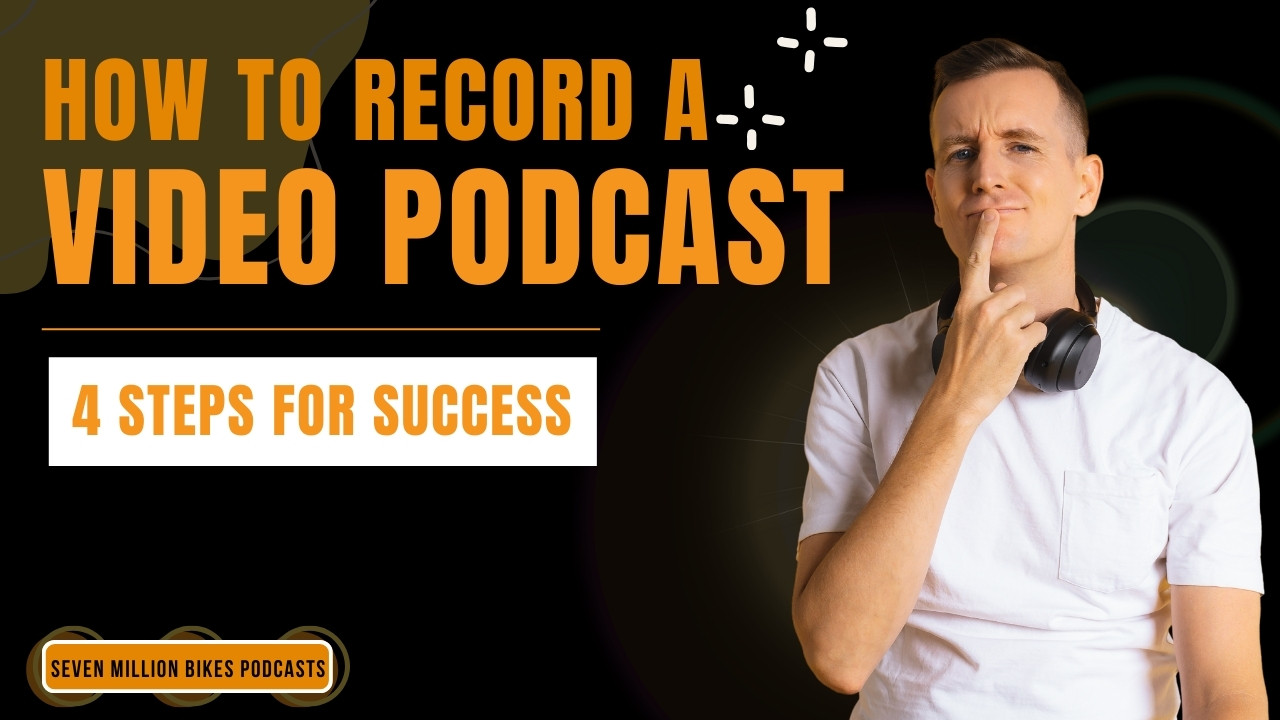Did you know that video podcasts are the fastest-growing segment of the podcasting industry? This isn’t just a passing fad; it’s a trend that’s here to stay, driven by our fundamental human desire for connection. Catching the industry trend is important, and I’ll show you how to record a video podcast.
I’m Niall Mackay, founder of Seven Million Bikes Podcasts. I used to think podcasts were strictly audio experiences, content consumed solely through headphones. However, video podcasts have completely changed my perspective by offering a dynamic and engaging format beyond just listening. Besides audio, I also offer a video version and invested in a podcast studio in Saigon.
I have to say that video podcasting is a lot more complex. It requires more planning and effort, from choosing the right format to setting up the recording space and equipment. Don’t worry, I’m here to help.
Let’s break it down and I’m sure you can start your video podcasts after reading this!
Table of Contents
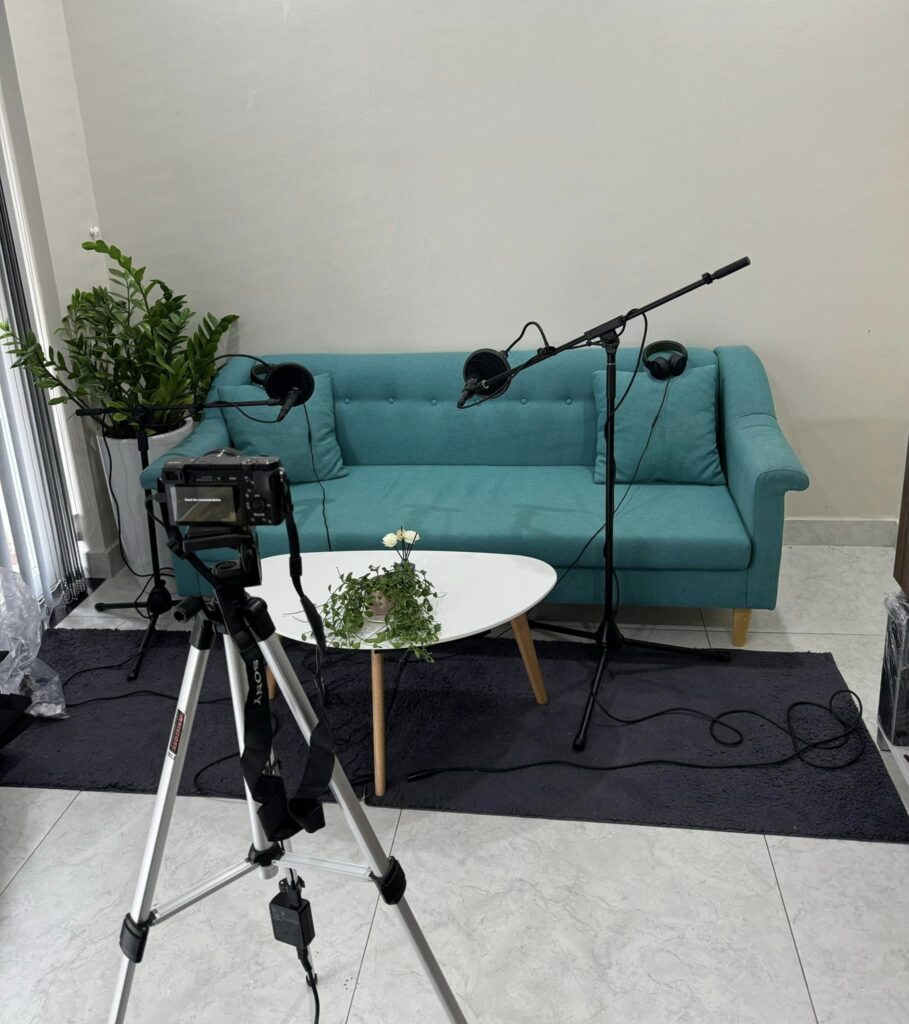
Understanding Video Podcasting
Podcasts have exploded in popularity in recent years, offering a diverse range of content readily available at our fingertips. But a new trend is taking the podcasting world by storm: video podcasts.
What is a Video podcast?
A video podcast is a form of podcasting that incorporates visual elements alongside traditional audio content. Unlike audio-only podcasts, video podcasts often feature footage of hosts, guests, or additional visual aids to complement the audio narrative. This can range from a static image accompanying the audio to a fully filmed show with multiple camera angles. Read about audio vs video podcast here to know more!
While quality equipment is crucial for capturing clear audio, creating a visually appealing video podcast demands an investment in space as well. If you don’t have enough budget to invest in a studio, let me help you!
Podcast Studio – A Solution
Seven Million Bikes Podcasts Studio (Saigon) offers a fully equipped solution, eliminating the need for you to worry about space limitations or acoustic treatment. We provide a state-of-the-art recording environment with everything you need to create high-quality video podcasts. Our professional setup includes top-notch lighting, high-definition cameras, and furniture, ensuring your podcast looks and sounds polished.
Why Video Podcasts Became Popular
Deeper Connection
Video allows us to connect with the hosts and guests on a more personal level. Seeing their facial expressions, body language, and overall presence adds a new layer of engagement that audio alone can’t replicate.
Moreover, video naturally holds our attention more than audio alone. The combination of sight and sound creates a more dynamic and stimulating experience for listeners, leading to higher engagement and retention.
Enhanced Learning
For educational podcasts, video opens up a world of possibilities. With video, educational podcasts become more interactive. Viewers can follow along with demonstrations, interact with on-screen graphics, and engage with multimedia elements embedded within the content. This hands-on approach encourages active learning and deeper comprehension.
This format also offers flexibility in how educational content is presented. Educators can choose from a variety of visual formats, including animations, screencasts, live demonstrations, and interviews. This versatility allows them to tailor the content to suit the subject matter and the preferences of their audience.
Broader Reach
Video content reigns supreme on social media platforms. By incorporating video, podcasts tap into a wider audience who may not have discovered them through audio-only channels. Besides, with the video version, you can share your podcast on platforms like YouTube, social media, and podcast directories, maximizing visibility and accessibility. Since the day I started video podcasting, I have much more content to share on social media and that is an effective strategy.
Essential Equipment For Video Podcast Setup
- Camera
The Podcast Camera is a new friend for video podcasting. It means you need to invest more time and money to choose the most suitable one. Let me show you more details in my podcast camera post, but take a look at the general information below:

DSLR (Digital Single-Lens Reflex) Cameras
DSLR cameras, renowned for their exceptional image quality and versatility, are a popular choice among video podcasters. With interchangeable lenses and advanced settings, DSLRs provide flexibility for achieving professional-looking footage.
Mirrorless Cameras
Alternatively, mirrorless cameras offer many of the same benefits as DSLRs but in a more compact and lightweight form factor. These cameras are known for their fast autofocus systems and excellent image quality, making them ideal for capturing moving subjects and dynamic scenes. Here are some pros and cons:
- Pros:
Affordable, portable, most people already own one, good enough for basic setups.
- Cons:
Lower video quality compared to dedicated cameras, limited control over settings (focus, aperture), and smaller sensor size can lead to poorer low-light performance.
Smartphone
Lastly, smartphones have become increasingly popular for video podcasting due to their advanced camera capabilities and user-friendly interfaces. Many modern smartphones are equipped with high-quality camera sensors, image stabilization, and intuitive video recording features. Popular options include recent iPhones and Samsung Galaxy models.
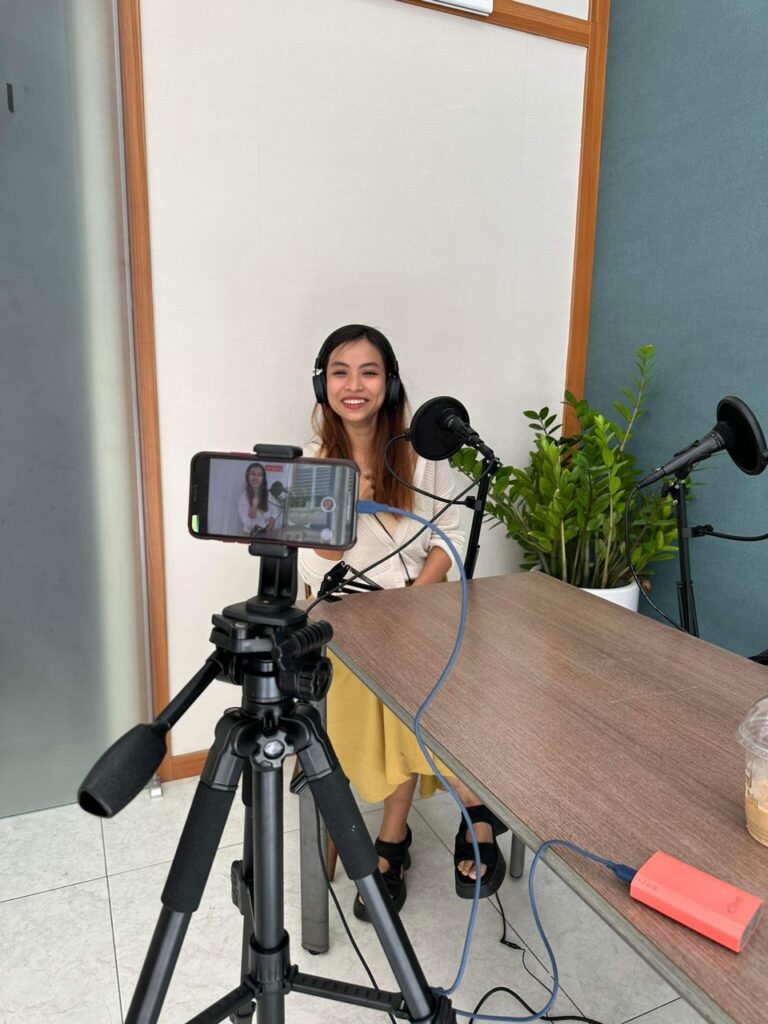
- Microphone
Podcast Microphones are the most important star in any podcast format. There are many types for you to choose:
- Condenser Microphones: Highly sensitive, capturing intricate details and nuances. Ideal for vocals and acoustic instruments. However, they can be more delicate and might pick up background noise in untreated environments.
- Dynamic Microphones: Known for durability and resistance to moisture. They have a cardioid polar pattern, focusing on sound from the front and rejecting noise from the sides and rear. Great for live performances and loud environments.
- USB Microphones: Plug-and-play convenience, perfect for portability and ease of use. They may not offer the same level of audio quality as professional setups.
- XLR Microphones: The industry standard for professional audio. They require an audio interface or mixer for use but provide superior sound quality and versatility.
To know more about each type as well as see some recommendations, read my old blog about podcast microphones.
- Lighting
Why Lighting Matters:
- Clarity and Detail: Good lighting ensures your face and any visuals (like notes or presentations) are clearly visible to your audience.
- Professional Polish: Proper lighting elevates the overall production value of your podcast, making it appear more polished and sophisticated.
- Mood Setting: Different lighting styles can create specific moods. Warm lighting creates a more intimate feel, while cooler lighting can convey a professional or serious tone.
- Flattering Appearance: Proper lighting can minimize shadows and blemishes, making you look your best on camera.
Natural Light
In the ideal scenario, natural light provides a soft, diffused glow that’s flattering for most skin tones. However, it’s only sometimes reliable. If you plan on using natural light, be mindful of the time of day and weather conditions. Recording early in the morning or later in the afternoon can provide softer light.
Ring light
Ring lights are a popular choice for video podcasters, particularly solo shows. They provide even, flattering lighting for close-up shots, eliminating harsh shadows and creating a soft, diffused look. Ring lights are relatively affordable and easy to use, making them a great option for beginners.
However, they may not be suitable for multi-host setups as the light source is directly in front of the subject.
Softbox
For multi-person podcasts, softbox lights offer a larger light source that creates soft, diffused light similar to natural light. They provide more control over light direction and intensity compared to other options, allowing you to create a more professional look.
The downside is that softbox lights are a more significant investment and require additional stands and setup.
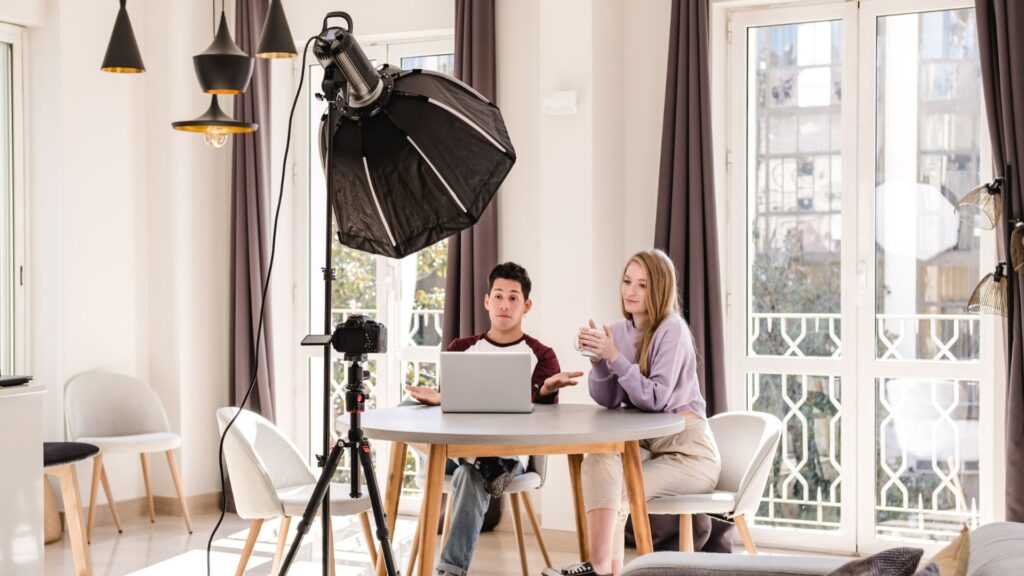
- Tripod
When it comes to recording video, one of the most common challenges faced by content creators is maintaining stability over extended periods. Holding a camera steady by hand for an extended duration can lead to shaky footage, which ultimately compromises the overall quality of the video.
Some features you should notice when choosing a tripod:
- Stability: Ensure the tripod offers sturdy construction and a stable base to minimize camera shake during recording.
- Height and Adjustability: Choose a tripod with adjustable legs and a center column that can be extended to your desired height for versatile shooting angles.
- Portability: Opt for a lightweight and compact tripod that is easy to transport and store, especially if you plan to record on location.
- Leg Lock Mechanism: Pay attention to the leg lock mechanism of the tripod, as it affects stability and ease of use.

- Headphones
Whether you’re recording audio or video content, headphones are indispensable tools that play a vital role in ensuring high-quality production.
Investing in a good pair of headphones may seem like a small detail, but it pays off in the long run. They ensure your audio is clear, professional, and polished, ultimately resulting in a more engaging experience for your listeners. So, don’t leave your audio to chance – equip yourself with a good pair of headphones and let your voice shine through in your video podcasts!
Here are some additional factors to consider:
- Comfort: Since recording sessions can last for some time, comfort is key. Look for headphones with comfortable ear cups and adjustable headbands.
- Sound Quality: Choose headphones that offer a clear and balanced sound signature, allowing you to accurately monitor and edit your audio.
- Impedance: Ensure your headphones have an impedance compatible with your audio interface or recording device.

How To Set Up For Video Podcasting
Setting up for a Video podcast is quite complex. Don’t worry if you have experience with audio podcasts. It just requires some additional steps. Let me guide you through this.
- Preparation
Planning and preparing is always an important step. It is even more crucial with the video version.
Content and Script
What topics will you cover? Who is your ideal listener? Is it a solo show where you share your expertise, a dynamic interview platform, or a lively panel discussion? This clarity shapes everything from equipment choices to recording style.
When it comes to video podcasting, preparing a script takes on added significance because, unlike audio-only formats, you can’t rely solely on voice inflections and nuances to convey your message. With video, your audience sees you, which means maintaining engagement visually is just as crucial as delivering quality content verbally.
They can be flexible outlines or detailed word-for-word guides, depending on your comfort level.
Equipment
Besides content, many podcasters fail at preparing their gear. Equipment failures or unpreparedness can lead to disruptions and delays during the recording session. This may require stopping the recording to troubleshoot issues, locate missing equipment, or make last-minute adjustments.
Here are the things I do to ensure my equipment is ready for the recording session:
- Create a Checklist:
Start by creating a checklist of all the equipment you’ll need for the recording session. This includes cameras, microphones, headphones, lighting equipment, tripods, memory cards, recording software, and any additional accessories specific to your setup.
- Gather Equipment:
Once you have your checklist ready, gather all the equipment from its storage locations and bring it to the recording space. Double-check that you have everything on the list to avoid any last-minute surprises.
- Inspect Equipment:
With all the equipment assembled, carefully inspect each item to ensure it’s in proper working condition. Check for any signs of damage, loose connections, or missing parts. Test electronic devices such as cameras, microphones, and headphones to ensure they power on and function as expected.
- Backup Plan:
Lastly, have a backup plan in place in case any equipment malfunctions during the recording session. This could involve having spare batteries, cables, SD cards or even backup recording devices on hand to quickly address any issues that may arise.
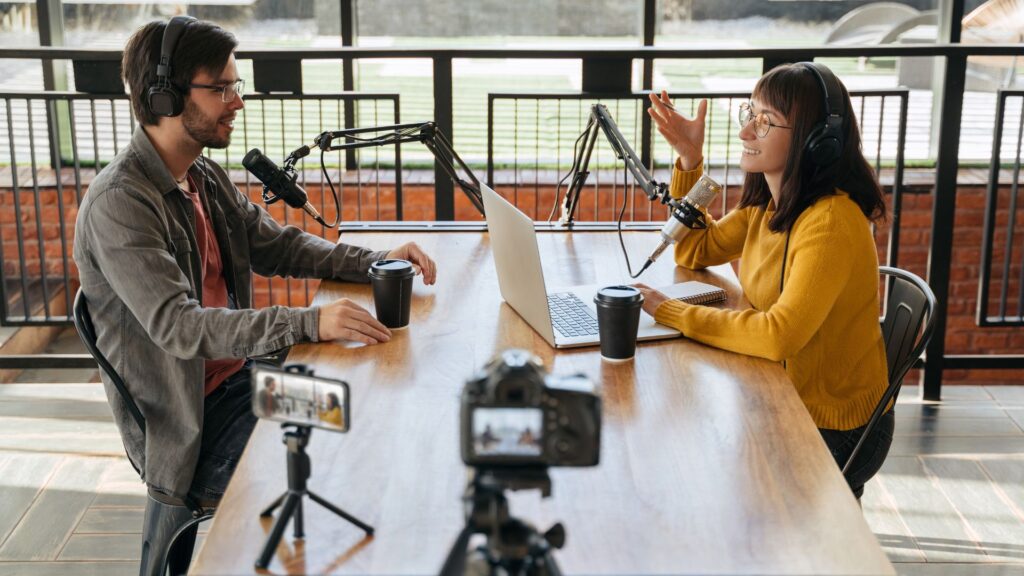
- Setting up The Recording Space
Now let’s begin the most important part, set up the space to start your podcast
Arrange Equipment Layout
Before starting the recording, arrange all necessary equipment in a layout that allows easy access and operation. This includes cameras, microphones, headphones, lighting equipment, and any additional accessories.
Organizing the setup beforehand minimizes disruptions during recording and ensures everything is within reach when needed.
For example, I also need to arrange the furniture like the sofa, the desk, and chairs for my guests and decide what angles to place the camera.
Position the Camera
Place the camera at eye level with the subject to create a natural and engaging perspective.
- Angle:
Experiment with different camera angles to find the most flattering and visually appealing setup for your video podcast. Consider factors such as the subject’s posture, facial expressions, and overall composition.
- Lighting:
Proper lighting is essential for achieving high-quality video footage. Position the camera in an area with adequate lighting or use artificial lighting sources to illuminate the subject.
- Stabilize with a Tripod:
Use a tripod to stabilize the camera and prevent shaky footage during recording. Choose a tripod with adjustable height and angle settings to achieve the desired framing and composition for your video podcast.
- Start Recording
With your equipment checked, your recording space optimized, and your pre-production steps complete, it’s finally time to hit the record button.
- Conducting a test run:
A test run allows you to troubleshoot any potential problems before recording your actual episode. This could be anything from flickering lights to distorted audio or blurry camera footage. Addressing these issues upfront saves you time and frustration later.
- Recording Session:
Throughout the recording process, stay focused on delivering engaging content, maintaining consistent audio levels, and ensuring that the subject remains in frame and well-lit.
While focusing on the conversation, occasionally glance at your camera to maintain good posture and eye contact. This creates a more natural and engaging viewing experience.
Tip: As an extra precaution, it’s a good idea to have someone monitor the camera while you’re recording to ensure that everything remains in frame and in focus. This person can help alert you to any issues with lighting, audio, or composition that you might not notice while you’re focused on delivering your content.
- After Recording
Take the time to watch through the entire recording to identify any issues, such as audio distortions, visual glitches, or mistakes in delivery.
- Transferring:
Depending on your recording software, you’ll need to transfer or import your recorded video and audio files to your editing software.
Then, create a clear and organized folder structure for your video and audio files, as well as any additional elements like music or intro/outro graphics.
- Editing:
Editing becomes even more crucial in video podcasting because, unlike audio-only podcasts, raw video recordings can present a wider range of imperfections. Some editing software you can choose is Descript, Adobe Audition, or Final Cut Pro.

However, editing video requires more skills and time.
Free Yourself to Focus on Your Passion: Podcast Editing Made Easy with Seven Million Bikes Podcasts
Creating a captivating video podcast takes time, effort, and a whole lot of passion. But let’s face it, editing that raw footage can be a real time-suck, especially when you’d rather be focusing on the next big idea for your show. Don’t waste your precious time wrestling with editing software. Let us handle the technical aspects while you focus on creating compelling content. Contact me NOW.
Conclusion
With audiences increasingly drawn to engaging visuals alongside captivating audio, video podcasting presents a dynamic opportunity to connect with your listeners on a deeper level. If you want to catch up with the industry trend, start your video podcast today.
This guide has equipped you with the knowledge to prepare, set up, and record your video podcast. Remember, the most important element remains your passion and unique voice. So, refine your concept, gather your equipment, and hit record!
If you have any questions about podcasting, don’t hesitate to book a FREE consultation with me.

